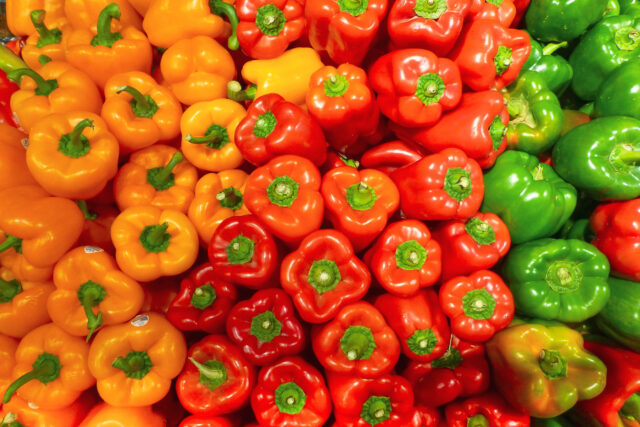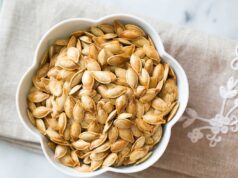Planting peppers is one of the most important steps in growing a healthy garden. Here are some tips for planting healthy peppers that will help your plants thrive.
Peppers are a great addition to any garden. They can be used for cooking, decoration, or just as an ornamental plant. However, if you want healthy peppers that grow faster, there are some tips that you should follow.
Peppers are (by far) our favorite plants to cultivate, as shown by the name of our website. Our grass may not always be perfectly green and cheerful, but our peppers always flourish.
In this post, we’ll go over some helpful hints for growing peppers. You’ll learn when to sow seeds, how deep to put them, how far apart to position plants, and other useful information.
Note: If you’re searching for a step-by-step approach to growing peppers from seed, check out our post on how to produce peppers from seed.
participates in different affiliate programs, which means that if you click on a link in this article and make a purchase on the associated website, we may get a commission.
 Peppers are being planted in the ground.
Peppers are being planted in the ground.
Variety of Peppers
The majority of pepper cultivars are simple to cultivate. Peppers are an excellent starting plant for novice gardeners because of this. Here are a few of the types we suggest as a starting point.
Peppers that are sweet
peppers with a kick (from least to most heat)
The universe of pepper varietals is enormous, so feel free to delve into all of the exciting possibilities. Look through some of our top seed vendors for types that appeal to you.
Temperature
Peppers thrive in temperatures ranging from 65°F to 90°F. However, most popular pepper cultivars in North America thrive at temperatures between 70 and 80 degrees Fahrenheit (21-27 degrees Celsius).
Pepper plants are not cold hardy, so wait till the winter season has gone before planting them outside. When the nighttime temperatures are regularly above 50°F, we typically move our pepper plants outdoors.
If your winters are cold, you’ll need to sow seeds inside or purchase ready-to-plant seedlings in the spring.
Pepper Seeds for Planting
Planting peppers indoors is generally essential if you’re starting from seed. You may be allowed to seed outside if you reside near the equator.
Plant pepper seeds inside approximately 6 weeks before the final possibility of frost in colder regions. After that, the plants should be ready to transfer outside in approximately 2 weeks, making the entire time from seeding to transplanting outside 8 weeks.
Pepper seeds should be sown at a depth of approximately 1/4 inch. The seed may struggle to emerge from the earth if it is buried much deeper. During germination, keep pepper seeds warm and wet at all times. More information on how to germinate pepper seeds may be found here.
 Plant seeds 1/4 inch deep.
Plant seeds 1/4 inch deep.
The process of ‘hardening off,’ or moving outdoors, necessitates a time of transition. This entails gradually increasing the quantity of direct sunshine your plants get on a daily basis. Here’s where you can learn more about hardening off.
Pepper Plants for Sale
Choose plants that seem to be healthy if you wish to develop starting plants. Look for plants with vibrant green foliage and steer clear of those with brown patches or fading leaves.
By carefully pulling the plant out of its growing container, you may inspect the root ball. It may be root bound if the roots are thick and twisted. Look for plants with roots that are just beginning to penetrate the soil’s depths.
 Pepper plant that is in good health.
Pepper plant that is in good health.
Always purchase plants when you’re ready to transfer them. This implies that evening temperatures will be regularly above 50°F (10°C) and will continue to rise.
spacing between peppers
Some pepper types may become very big and bushy, while others stay slim. The biggest peppers are ghost peppers and other C. chinense species, whereas jalapenos and other C. annuum variants are smaller.
In a nutshell, pepper plants should be spaced approximately 18 inches apart, stem to stem. Allow 2-3 feet (60-100 cm) between rows to allow you to stroll between them and pick your plants.
 In-ground pepper plant spacing
In-ground pepper plant spacing
Mulch the base of in-ground pepper plants to help retain moisture and prevent dirt from splashing onto the foliage.
When it comes to optimizing your pepper output, container size is crucial. In 3-5 gallon (11-19 liter) pots, most pepper plants will thrive. Bigger types, like as bhut jolokia, may benefit from even larger containers.
Fertilizing
Use an all-purpose fertilizer for potted plants, such as this one. This is particularly essential during the early stages of development. This guarantees that the plants reach their full potential, with plenty of lush green foliage.
It’s worth noting that high-quality potting soil typically has enough nutrients to last for many months. Check to determine whether you need to add more fertilizer to your bagged soil.
2 weeks before transplanting in-ground peppers, enrich the soil with a slow-release granular fertilizer. Use the appropriate quantity of granular fertilizer per 100 sq. ft., which is typically about 2 lbs. Work the fertilizer into the first 1-2 inches of soil using a rake.
Compost is also beneficial to the soil in garden beds. In the autumn or early spring, make your own compost using basic materials like yard clippings and dry leaves.
About halfway through the season, we suggest decreasing nitrogen. You have two options: cease fertilizing or switch to a blooming-stage fertilizer.
Watering
Pepper plants like wet soil that is uniformly distributed. Avoid allowing the soil to get too wet or too dry. Only water when the first 2-3 inches of soil are dry.
Allow potted plants to drain and make sure your garden beds drain properly to prevent overwatering. Raised beds are designed to have excellent drainage, while in-ground beds may vary. Plant peppers on mounds rather than flush with the ground if your garden does not drain properly.
Because bagged soil dries rapidly, potted plants will need more regular watering. Apply a thick mulch of straw or grass clippings to keep moisture in the soil for longer.
Pests and Diseases That Are Common
Peppers, like other crops, have adversaries. You may come into any of the pests mentioned below, depending on your area.
Pests of peppers:
- Aphids
- Thrips
- Spider mites are a kind of spider mite.
- Whiteflies
- Caterpillars
- Snails and slugs
- Grasshoppers
- Weavils
- Insects of the scale
 On a pepper leaf, slug.
On a pepper leaf, slug.
Planting a wide variety of companion plants is the best method to combat pests. Natural pest predators will be attracted to your garden if you have other plants. Predatory wasps, ladybugs, and other pest-eaters will be attracted to the flowers.
Spray with a garden-safe insecticidal soap if a pest population gets out of control. You may also release helpful insects in your garden to help keep pests at bay. Just make sure you know the bug you’re dealing with and which predator will be most effective.
Diseases may be just as bad for pepper plants. They may be spread via soil pathogens, pests, or cross contamination. A few diseases that harm pepper plants are listed below.
Diseases that affect peppers include:
- Spot on the pepper leaf
- Anthracnose
- Blight
- Virus that causes mosaics
- Dampening down (young plants especially vulnerable)
 On the pepper, there is a bacterial leaf spot.
On the pepper, there is a bacterial leaf spot.
Take measures in the garden by maintaining excellent hygiene, washing equipment at the end of the season, and mulching low leaves to prevent splashing. For the same reason, we suggest bottom trimming lower leaves.
Growing Instructions for Peppers
While peppers are very simple to cultivate, there are a few pointers to keep your plants happy and healthy. Here are a few quick tips to help you enhance your pepper planting.
- Plants should be staked. The purpose of staking is to give support for your plants. Winds become more vulnerable as the peppers mature and the plants grow higher. Plants should be staked with a strong stake and attached with garden velcro or thread to avoid damaged limbs.
- Don’t fertilize excessively. Pests are attracted to excess fertilizer, which may harm pepper plants. Only fertilize when absolutely required, and err on the side of under-feeding.
- Don’t over-water your plants. After rain or watering, allow plants to drain against the wall. To enable the water to drain, remove the bottom saucers from potted plants. Test the soil for drainage and plant on mounds if required for in-ground beds. Raised beds are built with excellent drainage in mind.
- Seedlings should be grown under grow lights. Early development is not optimal for pepper seedlings grown in a sunny window. While not strictly necessary, a grow light will guarantee that young plants get the energy they need to flourish. Furthermore, utilizing a light allows you to develop your seedlings in a room with no windows.
- When is the best timing to transplant? When seedlings outgrow their pots, they should be transferred as soon as possible. After the first 2-3 weeks of development, peppers usually outgrow seed cell trays. Examine the roots to check whether they’ve reached the bottom of the container.
- Early pepper pods should be picked. Pick off any tiny plants that are starting to produce peppers. The plant’s development will be stunted as a result of these tiny pods, resulting in a lesser yield.
Use our growing peppers guide for additional information and a comprehensive growing guide.
Pepper harvesting
Your peppers should start to mature 60-90 days after transplanting outside, depending on the type of plant. If you’re growing rocotos or any of the superhots, expect to wait 120 days or more before transplanting!
When peppers are completely mature, they become a different hue. If you’re storing seeds for next year’s sowing, wait until they’re fully mature before picking. Other varieties are often harvested earlier for a crunchier texture and more vegetal taste.
 Plant with ripe bhut jolokia.
Plant with ripe bhut jolokia.
This advice should assist you in growing peppers this year. If you have any queries, please leave them in the comments section below.

Calvin
One of the first s! Calvin enjoys traveling and performing music when he isn’t gardening or learning more about peppers and botany.
Growing peppers is not always easy, but there are some tips that can help you get the most out of your peppers. Reference: growing peppers problems.
Frequently Asked Questions
How do I make my pepper plant healthy?
Pepper plants need to be watered often and fertilized. They also need sunlight, so they should be placed outside in a sunny spot.
What to add to peppers when planting?
Soil, sand, and peat moss are the three main components of a good garden.
What is the secret to growing peppers?
The secret to growing peppers is a lot of patience. It can take months or even years for them to grow into a ripe, edible pepper.




